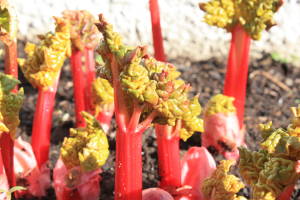Rhubarb is one of the few vegetables that is most frequently used as part of a dessert in Western cooking. Eaten raw, it has a strong, tart taste, which is dulled a bit when sugar is added and the plant is cooked.
Varieties of Rhubarb
Although there are different varieties available, it is rare that they are labelled as such. Most store-bought seeds will simply be labelled ‘rhubarb’. There is no need to be too concerned about the variety chosen.
Planting Rhubarb
Rhubarb likes cool temperate climates. Temperatures above 25°C (75°F) will slow its growth, but it likes warm soils in the early stages of growth. It can tolerate frosts but persistent below freezing temperatures are not well tolerated (do not eat if the stems go soft and mushy after a frost). Ideally, rhubarb will receive plenty of sun. It likes rich soil but can tolerate all but clay soil, in which case raised beds are required. pH should be between 5.5 and 6.5. It is mandatory to dig in rotted manure 3-4 weeks prior to planting.
It is not recommended to grow rhubarb from seed as it takes a number of years to harvest. If possible, buy a mature plant and divide it in to crowns (a small section of the plant with the roots still attached).
Plant the crown 2-3 inches deep with the top of the crown at the surface of the soil. Space the crowns 3 feet apart.
Growing Rhubarb
Keep rhubarb weed free and water regularly. Leaves will occasionally die and should be removed as soon as possible. In late Autumn and early Spring it’s a good idea to scatter a fertilizer around the crowns and to mulch around the crowns. Cut any flower stems that develop as this will negatively impact cropping the following year.
Harvesting Rhubarb
Rhubarb should not be harvested for 12-18 months in order to allow the plant to become established. To harvest the stems, hold them at the base and twist them off. The plant will last until the stems start to thin. It should be noted that rhubarb leaves are poisonous – just the stems are edible. If you make sure to leave a few stalks on the plant at all times it will continue to produce for many years.
Rhubarb will last fresh for around a week in the refrigerator, or can be frozen in seal-able bags.
Threats to Rhubarb
Rhubarb is prone to rot and fungal problems.

